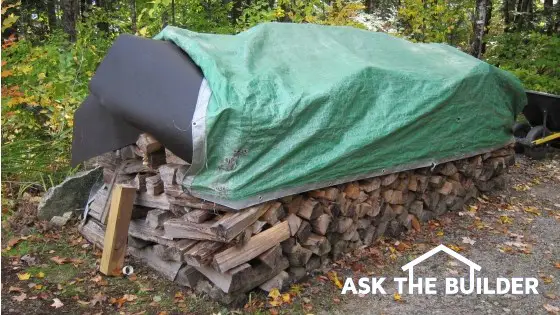Firewood Storage Tips

This firewood is protected from rain and snow. You can easily see the tar paper that covers the top of the firewood that's under the green tarp. PHOTO CREDIT: Tim Carter
DEAR TIM: I'm tired of trying to burn damp firewood. Neighbors of mine leave their wood unprotected as well. Right now I can't afford to build a nice firewood storage shed. I can't put it in my garage either as I'm worried about termites and insects. What are some affordable and effective methods to store firewood outdoors? I'm looking for stacking tips, and ways to help air dry the wood as well as keep it dry. Kelly L., Apple Valley, MN
DEAR KELLY: I see unprotected firewood piles all the time where I live here in New Hampshire. In fact, I see lots of neatly stacked firewood that has no top cover. I've always wondered how well that wood burns. No doubt you get a much hotter fire if the wood is dry, as some of the combustion BTUs are absorbed by the water and water vapor that is created as the damp wood cooks in the fire.
As you might imagine, I've seen, as I'm sure you have, all sorts of gorgeous and practical methods of covering firewood. A friend of mine has his own wonderful firewood shed that's adjacent to his home. I had plans drawn up for a new detached garage that had an extended shed roof at one end that was to be a giant firewood storage area.
There are endless possibilities with respect to firewood storage. But when money is tight and you need dry firewood stored outdoors, I'm a firm believer that some inexpensive tar paper and a fiberglass tarp are quite possibly one of the most practical methods to achieve the goal.
Many years ago, a retired engineer taught me how to stack firewood so it air dries quickly. The first thing to do is to split all the firewood to the size you intend to use when you burn it. Be sure when it's cut that it's the correct length to fit in your fireplace, wood stove or fireplace insert. You'd be surprised how many people try to maximize the length only to discover it's too long by an inch.
It's best to store the firewood off the ground. If you can afford some treated lumber 4x4s, these work great and can last decades. If you have access to some younger straight trees like some birch, you can cut those to make runners that are about 14 inches apart center to center. If you use trees, it's very important they be the same diameter. You want the stacked wood to be plumb so the piles don't tip over.
If you can't afford the treated lumber or don't have access to the trees, then at least store the wood on well-drained gravel. You just don't want the wood in contact with damp soil. This will allow the lower row of firewood to rot over time.
Think about the prevailing wind direction at your house. It's ideal to stack the wood so the long rows are parallel with the prevailing wind direction. Once the wood is covered, the piles act like a miniature wind tunnel as the wind blows through and across the wood.
At the end of each row of firewood, I usually have three stacks next to one another, you want to stack each successive layer at 90 degree angles to one another. This tower of firewood offers very good stability at each end so that the weight of the pile doesn't cause the wood at the end to tumble off the row.
I also keep about 6 inches of space between each row to promote air circulation. If you stack all the wood tightly, it takes longer to dry. If you do three rows of wood, try to make sure the center row is higher than the other two by about 4 inches.
Once you've got the wood all stacked, I usually go no higher than about 54 inches, then I cover the wood with two long pieces of overlapping tar paper. The higher center row of wood help ensure any water drains to the sides of the pile. I then cover the wood with a fiberglass tarp so the top is covered and it extends partially down the sides. I try to keep the ends of the rows uncovered as much as possible to promote great ventilation.
Don't cover the stack of firewood completely with a tarp. This traps water vapor and makes it nearly impossible for the wood to dry.
It's best to install some stakes and rope at the sides of the tarp to extend the tarp out away from the stacked wood much like a camping tent rain fly. These tarp wings ensure the sides of the wood stack don't get wet from all but the worst driving rain.
It's vitally important that you do everything possible to promote the movement of air through the wood if you want it to dry rapidly.
The real firewood pros stack and cover their wood for at least a year before they intend to burn it. This means you typically have two years worth of wood on site at the beginning of each wood-burning season.
Don't forget that some wood is easier to split when it's partially dry. Other wood is best split as soon as it's cut into links from the fallen tree. Talk to a professional woodsman to determine when it's best to split your wood. A hydraulic wood splitter will become your best friend if you intend to burn lots of firewood. I love my 27-ton hydraulic wood splitter.
Column 905
One Response to Firewood Storage Tips